Despite Star Wars and Star Trek and the many, many other movies and television shows that display a vigorous human presence in space, we seem more Earthbound than ever. More than 20 years have passed since we last set foot on the moon, and we have no concrete plans for returning. Mars now tantalizes us with meteorites bearing what might be traces of extraterrestrial life, yet the chances of our actually going there soon seem remote. To space enthusiasts yearning to break free from our terrestrial chains, this situation borders on the tragic.
Among the myriad obstacles that stand in the way of our leaving our planet, the most daunting is money--or rather, the lack of it. In spaceflight, money is synonymous with energy. Energy in turn means fuel. As pedestrian as it may seem, the chief factor limiting our ability to get a manned spacecraft to Mars and back is that we cannot finance a ship big enough to carry the necessary amount of fuel and to house astronauts for several years.
This situation may seem confusing at first. After all, we were able to rocket three astronauts and two space capsules to the moon and back again 28 years ago, and surely rocket engines have not gotten less powerful since then. Of course, Mars is about a thousand times farther from Earth than the moon. But this doesn’t necessarily mean that traveling there at the same speed would take a thousand times longer, or almost ten years one way--too long for any manned mission. Since Earth is barreling around the sun at something like 20 times the speed at which the Apollo spacecraft journeyed to the moon, it provides a convenient springboard for propelling a rocket quickly to Mars. Using Earth’s velocity in this way, a one-way trip would take only six months to a year, assuming the craft traveled at a speed (relative to Earth) only two or three times that of the Apollo missions.
Achieving this gain in speed seems as if it should be easy, but it actually costs a lot. To understand the problem, it helps to remember how a rocket works. Rocket propulsion depends on the law of physics called conservation of momentum. Put simply, this law states that if I throw something away from me, I will recoil in the opposite direction. Rockets recoil forward because they throw mass out their back ends.
The speed with which the rocket is propelled forward depends on three factors: a) the speed with which the propellant exits the back end; b) the mass of the propellant leaving the rocket; and c) the mass of the rocket plus the fuel remaining on board. These factors also come into play when I inflate a balloon. If I let it go without tying it off, air is expelled quickly, which propels it around the room. If the balloon were made of concrete, it wouldn’t go anywhere. If I inflate the balloon only a little, so that the walls of the balloon aren’t stretched very far and the air escapes out the back very slowly, it also won’t go anywhere.
With balloons, the additional mass of the air inside is negligible. Not so for real rockets: they require so much energy that the weight of the fuel cannot be ignored. And there’s the rub. If I want to move faster (and the speed of the propellant is fixed), then I have to throw back more propellant. But when I take on more fuel, it takes more energy to get that bit of extra mass moving, which means I need to pack more propellant still. Each increment in fuel needed to accelerate the ship requires another smaller increment in fuel to accelerate the now heavier ship. And so on, ad infinitum.
Does this infinite summing up of fuel mean that it will require an infinite amount of fuel to move at all? No. For speeds well below the speed of light, as long as the increments I keep adding to the sum get smaller fast enough--in this case, they do--the result will always be a finite amount of fuel. Finite, yes, but the amount also turns out to depend sensitively, in fact nearly exponentially, on the final speed of the ship relative to the speed at which the propellant shoots out the back. (The speed of the propellant and the speed of the spaceship are two very different things. As long as a spaceship is throwing stuff out the back, it will continue to accelerate, regardless of how fast that stuff happens to be moving.)
As this final speed begins to exceed the speed of the propellant, the cost in fuel really begins to blow up. For example, increasing the final speed of a rocket to twice the speed of the propellant will increase the required amount of fuel by a factor of almost 4. But to increase the final speed of the rocket to four times the speed of the propellant necessitates increasing fuel by a factor of more than 30. In that case, as the numbers work out, the initial mass of the ship plus fuel will be some 55 times the mass of the ship without fuel. In practice, things are even worse, since a ship designed to carry so much more fuel will generally have to be sturdier and thus weigh more. These considerations generally imply that a ship cannot practicably carry enough fuel to go faster than three or four times the velocity of its propellant.
The problems don’t end here. A round-trip voyage to Mars is at best a multiyear proposition. This means you have to design a spacecraft that can adequately house, feed, and provide a breathable atmosphere for astronauts for an extended time. Such a spacecraft would have to weigh substantially more than the Apollo capsule and require correspondingly greater amounts of fuel. This means that the net fuel required for a mission to Mars would be many times that associated with a voyage to the moon, even if faster speeds were not required.
And then you have to get back. When the Apollo astronauts went to the moon, they needed only enough fuel to break free of the moon’s feeble gravity. Mars has a gravitational field more than twice as strong, which is partly why you need almost as much fuel (relative to the mass of the now lighter spacecraft) for the return journey as you did for the outbound trip. Of course, if you need to bring this fuel along on the outbound journey, then you must add its mass to the initial mass of the spacecraft and recalculate the fuel requirement for the outbound journey. To get an idea of the problem this induces, say the fuel required to achieve a speed of three miles a second relative to Earth after leaving a low Earth orbit is five times the mass of the spacecraft with an empty tank. If you need a comparable ratio to get up to speed on the return journey, then you’ll have to land on Mars with a spacecraft that weighs six times the mass of an empty spacecraft (that is, the mass of the empty spacecraft plus five times the mass of the spacecraft in fuel). But this means that the mass of the initial spacecraft plus fuel at takeoff from Earth must then be 36 times the mass of the empty spacecraft. Pretty soon, to paraphrase rocket engineer Bob Zubrin, chairman of the executive committee of the National Space Society, you end up with Battlestar Galactica. This reasoning is more or less exactly what befell NASA in 1989 when it first officially estimated the cost of a round-trip mission to Mars at between $400 and $450 billion.
At such a price, going to Mars in this lifetime would remain a pipe dream. Fortunately, Zubrin and a few other space zealots have worked up a better, more affordable plan based on a simple tenet: Live off the land. Early explorers and settlers couldn’t bring all their food and supplies with them, so they hunted and scavenged on the very country they were exploring. The central feature of Zubrin’s approach is to send astronauts to the Red Planet in a craft containing only enough fuel for the outward voyage.
Who would be foolish enough to sign up for such a suicide mission? Well, it isn’t as crazy as it sounds. As Zubrin points out, fuel could be manufactured on the Martian surface using very simple technology. (So simple, in fact, that Zubrin, who is not a chemical engineer, has built a working prototype on Earth.) The Martian atmosphere, it turns out, is 95 percent carbon dioxide gas, which is easy to filter out and store, compressed and pressurized, as a liquid at Martian surface temperature. Zubrin’s proposal involves bringing along a small amount of hydrogen, which would make up only 5 percent of the propellant needed for the return journey, and reacting it with the carbon dioxide to produce methane and water.
Since this reaction is exothermic--that is, it releases heat--it requires no input of energy to drive it. All it takes is a catalyst of nickel or ruthenium, and the reaction occurs spontaneously. It is then a simple matter of separating the methane and water and splitting the water into its constituent elements of hydrogen and oxygen by the process of electrolysis. The hydrogen is recycled; the oxygen is refrigerated and stored. When it’s time to go home, just mix the oxygen and methane and-- voilà!--you have some of the highest-performing rocket fuel that can be stored for a long time.
Of course, there is a plethora of other worries--radiation exposure during the journey to and from Mars, transportation and power on the Martian surface, the size of the crew, and so on--but these only come into play once you know you can actually make the trip affordably. Depending on precisely how you deal with these issues, Zubrin estimates that a round-trip manned mission would cost anywhere from $10 billion to $50 billion. Not cheap by any means, but in the realm of the vaguely plausible.
Zubrin’s oxygen-methane in situ plant is not the only game in town. Engineers at the NASA Lewis Research Center in Cleveland have been exploring what seems to be a simpler reaction that doesn’t require any hydrogen at all. You can simply heat carbon dioxide in the Martian atmosphere, splitting it into carbon monoxide and oxygen, and use a zirconium oxide membrane to separate the two, which could then be burned as rocket fuel directly. There are some drawbacks. This fuel does not create as much energy as the methane-oxygen mixture, so you would need more of it. It also must be made at high temperatures, which would require energy from solar cells or a small nuclear reactor. And it burns too hot for most existing engines to handle. These last two, at least, are mere engineering problems. Once researchers at Lewis solve them, this method may become the first choice.
As attractive as these plans are, they still do not address the biggest physical stumbling block of conventional chemical rockets--the inefficiency of the fuel. Fuel performance is measured in specific impulse, which is the number of seconds in which a pound of propellant can produce a pound of thrust. The best rocket engines have a specific impulse of about 450 seconds. The methane-oxygen mixture described above has a specific impulse of 380 seconds, while the carbon monoxide-oxygen mixture has one of about 270 seconds. At any of these performance levels, fuel requirements would still be large enough to severely limit the size of the payload of a Mars mission--so much so that the final vehicle might have to be assembled in space and launched in two or three separate parts. To further reduce the amount of fuel needed, NASA engineers are exploring next-generation methods of propulsion under the guiding principle small is beautiful.
Consider the following challenge: You are stuck on very slippery ice. The only way to get back to ice-free land is to use propulsion. You could push yourself off a nearby rock very effectively. In this case, a lot of mass (the rock) moves away slowly when you push it, and you move away very fast. This assumes, however, that you do not have to bring your own means of propulsion--most people would not opt to carry a very heavy rock for such a purpose. Instead you might pack a few Ping-Pong balls. When you want to move on the ice, you unpack the balls and throw them one at a time. Each ball you throw, being very light, doesn’t give you much acceleration. However, since you can throw the Ping-Pong balls must faster than you can throw a heavy rock, and since it is not only the mass of the propellant that counts but also the speed at which it is moving, you may wind up moving faster by the time you have exhausted your supply of Ping-Pong balls than you would have had you used the rock.
This philosophy informs many of the current designs of high- performance engines. Remember that the amount of fuel needed depends exponentially on the ratio of the desired final speed of the craft to the speed of the propellant; the faster the propellant, the less mass you need. So the goal is clear: make the propellant speed higher and you win. To do this, you use a propellant that is light.
What could be lighter than hydrogen, whose molecule consists of a mere proton and electron, with an atomic mass of one? Hydrogen is the lightest gas we know of and therefore the best candidate to play the role of the Ping-Pong ball. This is the central idea of the nuclear thermal rocket spearheaded by engineer Stan Borowski at Lewis. Nuclear-fission reactors would heat hydrogen gas to a very high temperature (about 4900 degrees), which would send hydrogen molecules flying out the back end at high speeds. Borowski envisions such a rocket engine achieving a specific impulse of 900 seconds.
An even better prospect might be nuclear-electric propulsion. Here nuclear power would generate heat that would in turn be converted to electric power--just what Earthbound nuclear power plants do now. Powerful electric currents would knock electrons from atoms of liquid xenon or argon, turning them into positively charged ions, which would then pass through an electric field, picking up speed as they go. (The underlying principle is the same for the elementary particle accelerators that physicists build on Earth to get subatomic particles going at near light speeds.) By the time the ions fly out the back of the rocket engine, they would be going so fast that they would achieve a specific impulse of 5,000 seconds. They would be the ultimate Ping-Pong ball. With such an engine, we could travel to the planets with a small fraction of the fuel that chemical engines require.
There is no end, of course, to the number of schemes that space visionaries have cooked up for getting around the solar system--solar sails, nuclear fusion, antimatter rockets, and so on. All of these may come to pass eventually, but for the next several decades they are likely to remain in the realm of the fanciful. They are certainly not needed for a Mars mission. For that, all we need is the desire, and a way to do it without breaking the bank.














